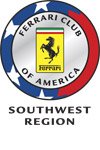
Ferrari in Japan
By: Shin Takei
We all know there are many Ferraris in Japan, but to understand what?s going on over there a little background history is necessary, so bear with me for a few paragraphs.
As a kid born and raised in Occupied Japan, I was able to see a nation bring itself up from the brinks of War to one of the leading economies in the world. Under the direction of the Supreme Commander of the Allied Forces, General Douglas McArthur, we were exposed to the American influence which has since changed forever the course of Japanese culture as we knew it until then.
Being a nation of Islands, Japan had been isolated for centuries and the culture goes back more than 5,000 years. Until the arrival of foreign traders and Commodore Mathew Perry in 1853, the nation had a self sufficient economy based on a staple of rice which was also a basis for taxation under the feudal system of the Shogunate. This sufficient and stable period had resulted in a country way behind the rest of the world. With the revolution at the turn of the century by the Emperor Meiji came westernization of Japan. But with the influence of foreign trade came yearning for the rare and exotic and the nation needed to import raw materials as well as commodities to feed its growing population.
The re-birth of the Japanese Empire brought on the industrial revolution and conflicts with the rest of the world. After embracing the Western way of life Japan had grown at a rapid pace and even beat the Imperial Russian Navy at its own game in the Russo Japanese War. This lead to trade restrictions beings levied against Japan from the rest of the Empires who sought colonies all over the third world. Needing rubber and fuel, and raw materials, Japan also jumped on the wagon to establish colonies in Southeast Asia. As the power shifted from the Imperial Household to modern government, the military took a strong presence and control of the nation using the Emperor as a symbol to rally behind. This lead to further complications with the rest of the World and eventually became the reason for their attack on Pearl Harbor. This brings us up to the defeat and the re-birth of Modern Japan.
Thanks to that, I was brought up on Gerber?s baby food and Campbell?s soup, as well as Kellog's corn flakes, just to name a few items available through the thriving black market, courtesy of the United States Occupying Armed Forces. Obviously cigarettes and liquor as well as appliances were available too. The black market prices were better since the G.I.?s purchased them from their P.X.s in their Bases and illegally dumped them on the eager public. Without this, we were relegated to rations of rice, vegetables and fish, a perfectly natural and healthy diet and cooked in hibachis since natural gas and electricity were not yet available to all areas.
All large conglomerates were disbanded and every citizen started a new life with the issuance of one hundred yen which was worth a little more than a quarter. My parents were both working hard like everyone else in post war-torn Japan. However, the mood was upbeat because everyone started from scratch, and the Constitution of Japan, largely penned by the United States, had eliminated ownership of weapons, namely firearms and swords resulting in a safe environment. As the nation tried to pull out of the rubble, they were enjoying the first experience of democracy. Many artists, musicians and writers came to light as freedom of speech and expression never enjoyed before were now legal
Imbedded forever in the memories of those living in Japan were the images of General McArthur, tall handsome and not unlike a Hollywood movie star. His corn cob pipe and Rayban sunglasses became a trademark of the American Style as we knew it at the time in Japan. His popularity can only be eclipsed by the sudden and unfortunate removal from his tenure by President Truman. Not surprising, he remains
